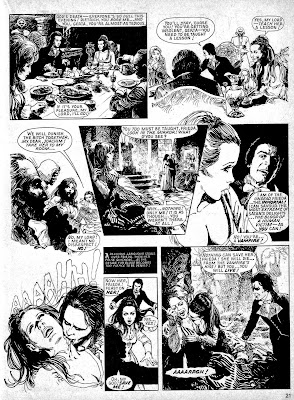Book Review: 'The Ancient Enemy' by Donald Thompson
2 / 5 Stars
‘The Ancient Enemy’ ( 220 pp) was published by Fawcett Crest in 1979; the cover artist is uncredited.
It’s no major spoiler to disclose that the subject of this horror novel is………carnivorous insects.
As the novel opens, its protagonist, Dr. Roberto Costaign, is driving up into the mountain country of Nevada, looking forward to a week of vacation.
Author Thompson knows he’s not writing for the Quiet Horror crowd; by page five, Costaign witnesses a disturbing sight: a nude young woman is staggering down the side of the road, her long blonde hair askew, her body covered in blood….!
Costaign takes the young woman into the nearby town of Cherakowa. There, Sheriff Anton Whitney asks Costaign to accompany him back up the mountain road to where the woman probably was working: the brothel known as Eros Ranch.
Arriving at the Ranch, Costaign and Whitney find the Ranch to be……you guessed it…..Eerily Quiet.
A bit of poking around reveals.......... a scene of shocking horror……..!
Has Plague descended on the hapless Eros Ranch ? Sheriff Whitney returns to town and calls the state health department to ask for an epidemiologist.
But the Mayor of Cherakowa asks him to lay off any further intervention………for the town is just starting its Centennial Festival, a major moneymaker. The last thing Cherakowa needs is rumors of plague, a state task force, and blocked roads.
Against his better judgment, Sheriff Whitney agrees to soft-peddle the disaster at the Ranch just long enough for the Festival to close…..a decision that will have fateful consequences. For the epidemiologist – an attractive woman named Pat Symington – isn’t the only person heading to the Ranch. A group of Working Girls and their Vietnam Veteran boyfriends have decided to stop by the Ranch, too………..setting up a confrontation with a group of homicidal bikers bent on revenge against the Sheriff.
And just under the soil surrounding the Ranch, the Ancient Enemy is preparing to come out with the arrival of dusk………there are many of them, and they all are hungry……..
‘The Ancient Enemy’ is a classic late 70’s eco-horror novel, one with thematic resemblances to movies like Willard, Phase IV, Frogs, and Squirm.
Author Thompson’s prose style is not particularly sophisticated: men Squiggle through bushes, and water Giggles Out through a tiny hole.
But, to be fair, such writing isn’t all that much different from the purple prose Ramsey Campbell used in his stories of the era, stories frequently considered among the 'Year’s Best Horror Stories'.
And ‘The Ancient Enemy’ has a narrative that is fast-moving and action-centered, making it a jolt of adrenaline when compared to the labored, overwritten horror stories of Charles L. Grant, Dennis Etchison, and T. E. D. Klein that were garnering much praise in the late 70s.
Summing up, I can’t recommend ‘The Ancient Enemy’ as a must-read. But if you are fond of those low, low budget ‘creature’ films that air on the SyFy TV, then you may want to pick up a copy.































































.jpg)



















